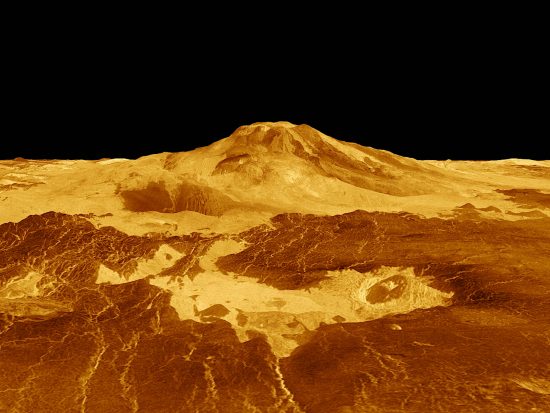
September 11, 2020
Electricity can create structures that are hard to identify.
Venus underwent some kind of cataclysmic event (or events) in the recent past. Giant cracks extend for hundreds of kilometers, for example. Those fractures are accompanied by “coronae”, with deep channels branching out like carved lightning bolts. Vast caldera with upraised rims and glassified, crazed interiors dominate the landscape.
According to a recent press release, planetary scientists believe that volcanic upwelling melted and swelled the surface. When it subsided, the magma cooled and contracted, leaving behind a network of fractures. Features such as Maat Mons, therefore, are the remains of volcanoes that might still be active.
However, in an Electric Universe, those formations resemble lightning scars. The cracks are trackways—the remains of electric arcs raking the surface, and the mounds are giant fulgamites. A fulgamite, or lightning blister, develops when an electric discharge pulls charged material from the surrounding area, incidentally dragging the neutral matter with it. A large enough electric arc will act like an enormous plasma tornado, with an extremely low pressure region in the center enclosed by powerful electromagnetic fields. It is this central vortex that can exert forces that crush and melt dust and other substances until they become stone.
The word, “fulgamite” is uncommon. It appears that it was used first in a paper published by R. D. Hill in the Journal of Geophysical Research 11/1963; Volume 68. Hill’s paper, Investigation of Electron Runaway in Lightning, mentions that lightning rod end caps would sometimes show “mounded” circular formations, “melted and raised above the surface of the metal.”
According to Ralph Juergens in his paper, Of the Moon and Mars, Searching For The Scars Of Battle (Pensée Journal II, 1974):
“He [Hill] describes the sides of these fulgamites as ‘usually ridged with closely spaced concentric grooves’ and their bases as ‘usually flared like a bell’. And he remarks: ‘Sometimes the position of the strike is found to wander slightly during the formation of the mound [[as]] shown by the shallow development of the “borrow pits” [[concentric graben?]] from which the mound is built up’.
“Hill attributes the mounding-up of fulgamites to magnetic-pinch forces at the junction of the discharge with the electrode (lightning rod). His calculations indicate that such forces in a lightning column are easily adequate to raise metallic welts a centimeter or so in diameter, and they neatly account for the bell-shaped fulgamite surfaces as well. The concentric rings and ridges, in his opinion, are best explained as remnants of ripples set up in the molten surface during fulgamite formation by oscillations in the plasma of the lightning column.”
Electromagnetic pinch forces can be extremely powerful. They are capable of drawing charged particles toward them, which, in turn, drag neutral matter into the center of a compression region. The material is squeezed into a tightly confined area where it might become consolidated. This phenomenon occurs because of the “Bennett Relation“, named after Willard Bennett.
In previous Pictures of the Day about Venus, it was suggested that geological features should not be viewed in isolation. Craters with wide, flat floors and steep sidewalls; terraced, sinuous canyons with vertical walls, scalloped edges, no outflow debris, and flat bottoms; mesas with forty-five degree “shoulders” and escarpments that are cut by parallel grooves; faults with no sign of strike-slip, with other faults cutting across them at ninety degrees–those formations are anomalous, indeed.
Shield volcanoes and pedestal craters are visible through the clouds. Such geology is difficult to explain, unless electrical activity is invoked. Gigantic plasma discharges pull material toward them into the center of a vortex. After an electric arc passes, a raised mound of debris remains. Some mounds, like Eistla Regio, can be very large.
Probably the most important aspect about Venus is its anomalous electric field. Electric Universe advocate, Wal Thornhill is sure that the raised mounds and the mountain tops on Venus are electrically energized:
“…diffuse electric discharge, known on Earth as ‘St. Elmo’s fire’, occurs preferentially at the higher altitudes of the mountains on Venus. In that thick atmosphere it forms a highly conductive dense plasma, which is a superb reflector of radar signals. The density of the atmosphere at the surface of Venus is about 1/10 that of water. St. Elmo’s fire is a highly ionised state involving actual discharge. Put the two together and you have dense plasma – which conducts like a metal and therefore reflects radar like a metal surface.”
This explains why some areas on the surface are so reflective to radar: St. Elmo’s Fire is a plasma phenomenon, similar to static electricity, and charged plasma reflects radar like a mirror.
How Venus was formed and how its blasted and burned surface came about must include electricity’s power. Energetic discharges propagated through its dense atmosphere, leaving the aforementioned structures scattered across its surface. Those cosmic lightning bolts account for the terrain, the electromagnetic field, the temperature variations, the polar vortices and many other aspects.
Stephen Smith
The Thunderbolts Picture of the Day is generously supported by the Mainwaring Archive Foundation.












